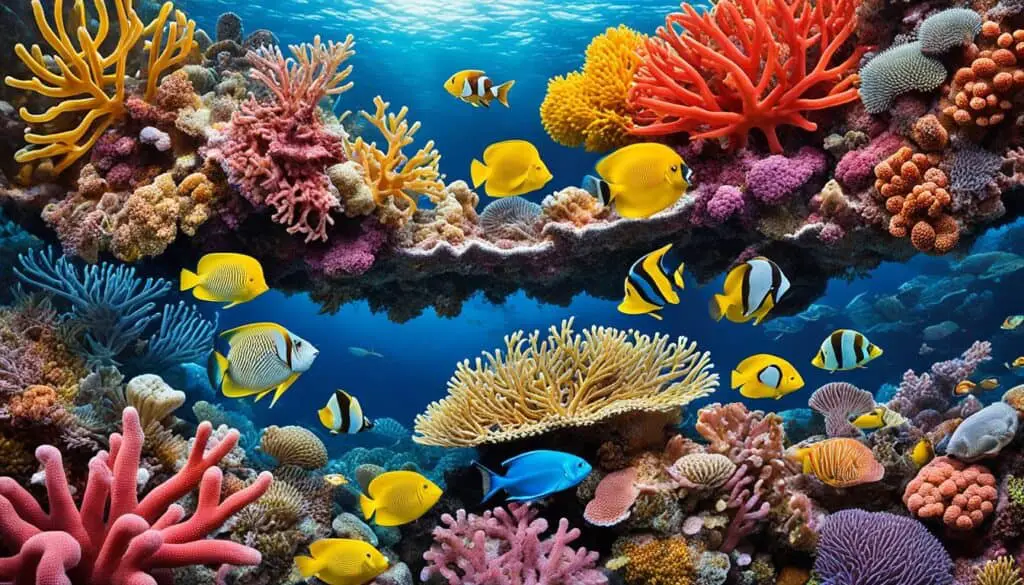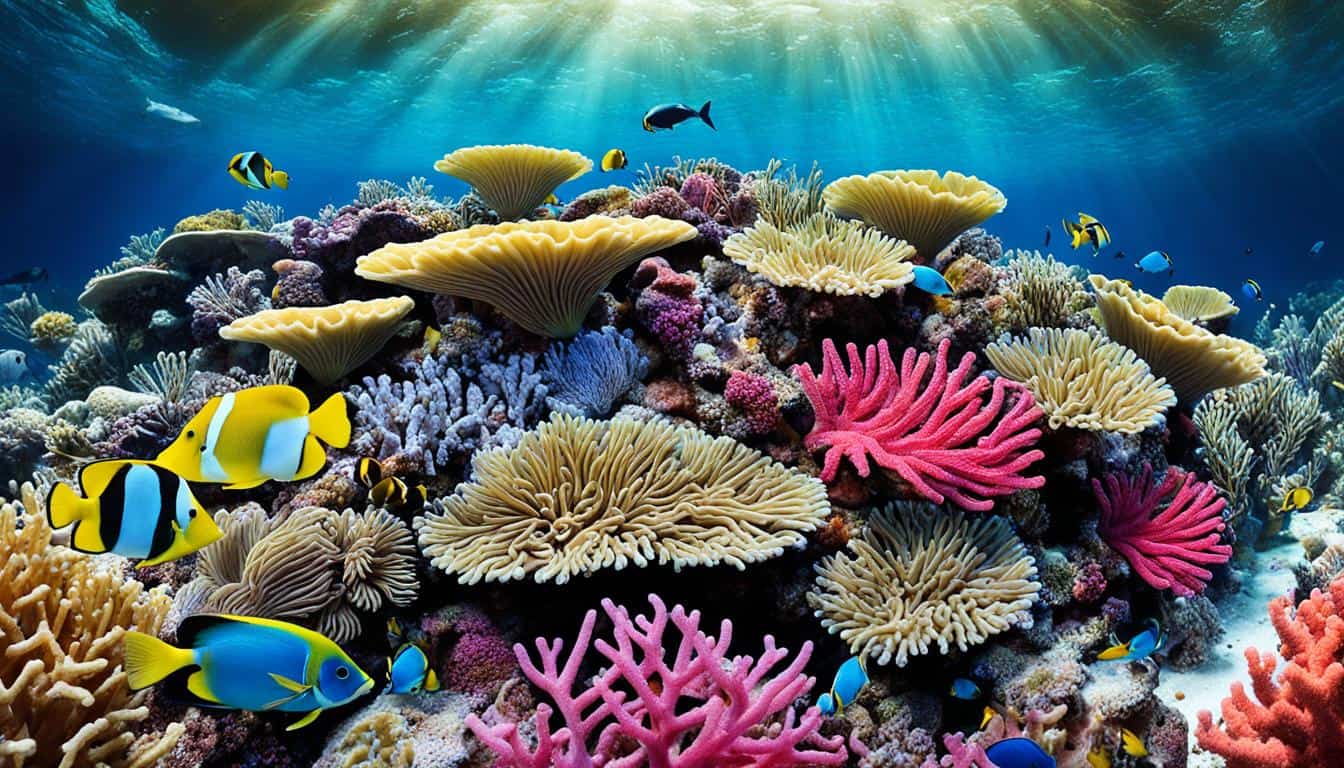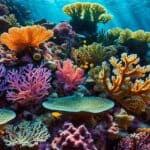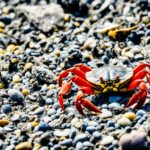Coral reefs are often called the “rainforests of the sea” because they are so diverse. They support about 25% of ocean fish. These fish depend on coral ecosystems for shelter and food.
It’s important to know how corals work with other sea creatures. They have a special relationship with zooxanthellae, which help them survive. But, these relationships are at risk from pollution, climate change, and overfishing.
That’s why we need to work on coral conservation. It’s key to saving these important marine environments.
Understanding Coral Reef Ecosystems
Coral reef ecosystems are key to marine life, with some of the most diverse life on Earth. They exist in small ocean areas but support a huge variety of marine life. These ecosystems show how complex and detailed coral reefs are.
The Importance of Biodiversity in Coral Reefs
Coral reefs are vital because of their high biodiversity. Over 25% of marine life depends on them for survival. This means that the health of these reefs affects many marine species.
Diverse species help keep the ecosystem stable. This makes coral reefs crucial for fighting against environmental threats.
Essential Habitat Structure Provided by Corals
Corals create a complex structure that is key to these ecosystems. This structure supports many marine species interactions. It provides homes and breeding grounds for various organisms.
This shows why it’s important to protect coral reefs.
Role of Corals in Supporting Marine Species
Corals do more than just exist; they play a big role in marine ecosystems. They provide homes for many species. This shows how important corals are for the health of the ocean.
Protecting these reefs is key to keeping marine life diverse and healthy.
How do corals interact with other marine life?
Corals and other marine species have complex and beautiful relationships under the sea. They form symbiotic bonds that help corals and support many other marine lives. These bonds show how vital corals are to the health of the ocean.
Symbiotic Relationships: Corals and Zooxanthellae
The partnership between corals and zooxanthellae is key to reef health. Zooxanthellae, photosynthetic algae, live inside the coral. They give corals important nutrients like carbs and oxygen in return for a safe home. This helps corals grow strong, especially in areas with little food.
Corals and Reef Fish: Mutual Dependence
Corals and reef fish have a special relationship. Many fish rely on corals for a place to live and breed. Corals protect them from predators. Some fish even help corals by eating algae that could harm them.
This back-and-forth shows how important corals are to the ocean’s balance. Each species helps keep the reef healthy.

Coral Biodiversity and Its Impact on Marine Life
Coral reefs are key to the ocean’s health, home to many marine species. Each one, from fish to algae, is vital for the reef’s balance. These relationships boost coral biodiversity and keep the reef healthy.
Diverse Species and Their Functions in the Ecosystem
Reefs are full of different species, each with its own job. Some fish clean corals, while others help with nutrient cycling. This variety supports coral life and makes the reef stronger against threats.
With many corals, the reef becomes a home for more marine life. This leads to a healthy community.
Interactions Between Herbivores and Coral Diversity
Herbivores like parrotfish and surgeonfish are key to reef health. They eat algae, stopping it from taking over the coral. This helps corals grow and keeps the reef diverse.
But when these fish are fewer, coral life can suffer. The balance between herbivores and corals is vital for the ocean’s health.
Marine Species Interactions in Coral Reef Food Webs
In coral reefs, knowing how marine species interact is key to understanding their health. Predatory fish play a big role in the food web. They keep smaller fish and invertebrates from getting too numerous. This helps prevent overgrazing and stops macroalgae from taking over, which can harm corals.
The Role of Predatory Fish and Coral Health
Predatory fish like lionfish and groupers help corals by keeping the ecosystem balanced. If herbivorous fish eat too much coral, it can stress corals and make them bleach. So, keeping predatory fish healthy is important for coral reefs to thrive.
Corallivorous Fishes: Feeding Modes and Their Impact on Corals
Corallivorous fishes eat coral and can be a challenge for coral health. They have different ways of eating, like polyp-feeding and skeletal-feeding. While some help corals by promoting new growth, too much eating can weaken corals. This makes them more likely to bleach.
Understanding how these fish interact is crucial for saving coral reefs. It helps us make better plans to protect them from threats like climate change.
FAQ
How do corals interact with other marine life?
Corals have complex relationships with many marine species. These relationships are key to keeping coral reefs healthy. For example, corals give homes to many fish and invertebrates. In return, these creatures help keep the corals healthy.
What is coral symbiosis and why is it important?
Coral symbiosis is the bond between corals and zooxanthellae, algae living inside the coral. This relationship is vital. Zooxanthellae make food and oxygen for the corals. Corals protect the algae, letting them grow well.
How does coral biodiversity contribute to the ecosystem?
Having many coral species makes reefs more resilient. This diversity supports a wide range of marine life. It creates a strong food web and helps marine species interact.
What habitat structure do corals provide?
Corals build important homes for many reef animals, like fish and invertebrates. These reefs offer shelter and food. They are key to the health of ocean life.
How does the relationship between herbivores and corals work?
Herbivores, like parrotfish, eat algae that could harm corals. Their eating helps keep coral species diverse. This supports coral health and a healthy ocean.
What is the role of predatory fish in coral reef ecosystems?
Predatory fish keep the balance in coral reef food chains. They control the numbers of smaller fish and creatures. This balance stops algae from taking over, helping corals and marine life thrive.
What are corallivorous fishes and how do they affect corals?
Corallivorous fishes eat live coral. Some help corals by spreading coral babies, but too much eating can hurt corals. This makes them more likely to suffer from coral bleaching caused by climate change.







